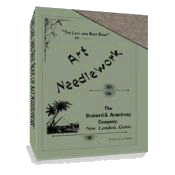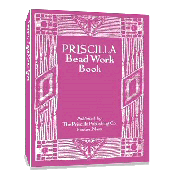A Victorian Knitting Needle Case
- or Two -
Every Victorian lady most likely owned a knitting needle case or two. So much of the clothing, accessories and even household item were knitted. A number of different sizes of needles were needed for the wide variety of items that were made. Keeping them safe and organized was simple when a case was used.
Here are two cases, both very similar, but different enough that you may find one more to your preference - both in use and in making.
Knitting Needle Case No. 1
At this time I cannot state what book I found it in. My notes only say c. 1887. When I find the information, I will add it here. This article was edited for use on this site.

This case is formed of dark blue kid-chamois leather and blue ribbon.
Cut a piece of kid, 11 inches by 9 inches, fold it in half, and round off the edges as shown in the diagram. Unfold the kid, line it with chamois leather, and bind it round with narrow ribbon.
Make the divisions for the needles with narrow ribbon, and embroider the numerals (corresponding with the knitting needle size) on them. Fold over the flaps, roll up the Case, and tie it round with ribbon.
If kid chamois leather is not available, any heavy material may be used. Coordinate the color of the ribbon to match or contrast nicely with the fabric.
Knitting Needle Case No. 2
Mrs. Leach's Fancy Work Basket, 1887. This article was edited for use on this site.
This case is intended to hold knitting needles when they are out of use, and to prevent them from becoming rusty. Modifications of it can be made to suit other purposes, as will be shown hereafter.
The outside may be made of satin, plush, velvet, brocaded satin, cretonne, or, indeed, of almost any convenient material. It must be cut rather wider than the longest knitting-needle that it is to contain, and about 3 times as long as it is wide.
The one end must be rounded in flap-form, and 2 long and narrow flaps cut to fold over the knitting needles at the sides, and prevent them from falling out These flaps must he of the same length as the case is without the rounded flap, and about a third the width of the case.
A set of 3 pieces of chamois leather must next be cut to line the case with, but before tacking them into the outside cover, cut a long narrow piece of the wash-leather, and lay it down the centre of the largest piece, making a few runnings or stitchings across its width, into which the knitting-needles are to be slipped. Then lay the wash-leather linings in place against the outside cover, and tack them well all round to keep them in their places.
Bind each piece neatly ail round with ribbon, sew the side flaps to the centre part, and add strings of ribbon to tie round the case when it is rolled up.
The side flaps may be cut all in the same piece with the centre part if preferred, but then more difficulty will be experienced in folding them straightly over the contents, when the case is to be rolled up.
By making the centre strip nearly as wide as the case itself, and by putting the rows of stitching rather further apart, a useful case for crewel silks or wool can be made. Of course it need not be lined with wash-leather.
Made of baize, these cases are useful in a house for stowing away fish or dessert knives and forks, while made of some more dainty material they are acceptable to young art students for containing their pencils.
Return to top of Knitting Needle Case page.
Return to Victorian Crafts page.
The Last and Best Book of Art Needlework
Over 100 pages of authentic Victorian instructions and patterns from 1895!
FREE
Beeton's Book Of Needlework

433 pages!
Sign up for VEAC! Everything you wanted to know about Victorian embroidery, needlework, crafts and more!
Priscilla Bead Work Book
Make Beautiful Victorian Beaded Purses, Jewelry & Accessories - Starting
TODAY!




